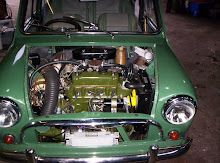The fan belt, which also drives the generator or dynamo, should be kept free from grease and should be correctly tensioned. There should be a free movement of one inch at the centre of the belt between the fan and generator pulleys. If the belt is too slack, it will slip; on the other hand, if it is too tightly adjusted, excessive wear will occur on the fan and generator bearings. It is a simple matter to adjust the tension by loosening the two upper mounting bolts on the
Clutch adjustment (standard-transmission models):
1, pull the operating lever in the direction of the arrow;
2, adjust the clearance generator and the clamping bolt on the strut, allowing the generator to be swung towards or away from the engine.
The only snag is that the bolt on the strut is rather inaccessible, but if yours is not one of those Minis which have non-detachable radiator grilles, the best plan is to remove the securing screws and take off the grille. The bolt in question is then easily accessible as are also the ignition distributor, dynamo and starter. The owner of a Riley Elf or a Wolseley Hornet scores in this respect, of course, as the grille rises with the bonnet.
To increase the tension on the belt, pull the generator outwards; do not use any leverage. After the mounting bolts have been tightened, re-check the free movement of the belt.
The belt must be kept free from grease or oil. If it develops a squeak or a whistle, dust it with French chalk or smear the edges with a little brake fluid.
Eventually the time will come when the limit of the available adjustment is reached and a new fan belt will be required. Fitting is not too difficult, provided that one of the fan blades is aligned with the recess provided in the radiator cowling, just below the water hose on the right-hand side, as viewed from inside the engine compartment. Sufficient clearance will then be available for the belt to pass between the blade and the flange of the cowling, one blade at a time.



0 comments:
Post a Comment